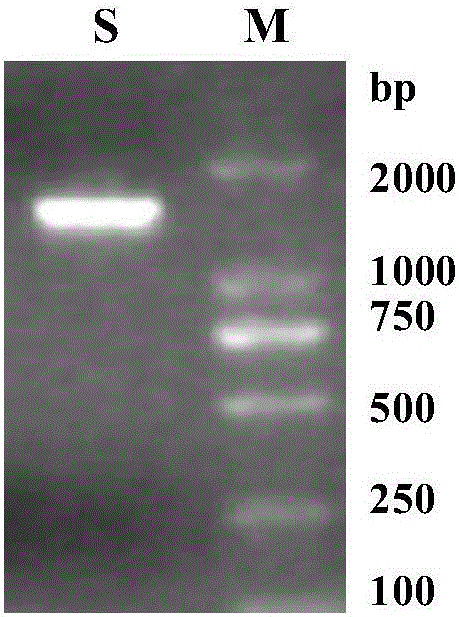Bacillus subtilis ZNXH1 sourced bacterial laccase gene, bacterial laccase and application thereof
A technology of Bacillus subtilis and bacteria, applied in application, genetic engineering, plant genetic improvement, etc., can solve the problems of industrial dye wastewater discharge, dye wastewater can not be effectively zero pollution, energy consumption, etc.
- Summary
- Abstract
- Description
- Claims
- Application Information
AI Technical Summary
Problems solved by technology
Method used
Image
Examples
Embodiment 1
[0026] Embodiment 1: the expression and the preparation of bacterial laccase CAHH1 gene cloning and bacterial laccase CAHH1 comprise the following steps:
[0027] (1) Cultivation of Bacillus subtilis ZNXH1 and extraction of chromosomal DNA
[0028] Inoculate the strain of Bacillus subtilis BS168 (available from Shanghai Beinuo Technology Co., Ltd., Beijing Tianchenze Biotechnology Co., Ltd., etc.) into 0.5 mL of LB liquid medium (the components of each 100 mL of medium are as follows: 0.5 g of yeast powder, 1.0 g peptone, 1.0g NaCl, the rest is water, pH = 7.6), 37°C, 180rpm, shaking culture for 2h, pour it into an empty petri dish, place it at 30cm of ultraviolet lamp (20W) and irradiate it for 20s with an interval of 20s , a total of 3 times of irradiation. Then take 100 μL of bacterial liquid and spread it on the LB agar culture plate (the components of each 100 ml medium are as follows: 0.5g yeast powder, 1.0g peptone, 1.0g NaCl, 0.5g agar powder, the rest is water, pH=7....
Embodiment 2
[0048] Embodiment 2: the characteristic of bacterial laccase CAHH1
[0049] (1) Optimum reaction pH and pH stability
[0050] pH value is an important factor affecting the catalytic activity of enzymes. Usually the enzyme shows the maximum catalytic activity at a certain pH value, and the farther it deviates from this pH value, the lower the catalytic activity of the enzyme. The maximum pH range detected by the catalytic activity of bacterial laccase CAHH1 of the present invention is 2.0-9.0 .
[0051] Using ABTS as a substrate, the activity of bacterial laccase CAHH1 in buffer solutions with different pH values (2.0-9.0) was measured, and the relative enzyme activity under other pH conditions was calculated with the highest enzyme activity as 100%. The relative activity of the enzyme was plotted against the pH value ( Figure 5 A), the results show that the optimal pH value of bacterial laccase CAHH1 catalyzing ABTS is 4.6.
[0052] After incubating bacterial laccase CAHH...
Embodiment 3
[0057] Example 3: Co 2+ with Mn 2+ Effects on the Catalytic Activity of Bacterial Laccase CAHH1
[0058] With ABTS as substrate, cation Co 2+ and Mn 2+ The effect of (10mM) on the catalytic activity of bacterial laccase is shown in Figure 7, and the relative enzyme activity under other conditions was calculated with the enzyme activity of the control group as 100%. The results proved that: Co 2+ and Mn 2+ Both have the effect of enhancing the catalytic activity of bacterial laccase CAHH1.
PUM
 Login to View More
Login to View More Abstract
Description
Claims
Application Information
 Login to View More
Login to View More - R&D
- Intellectual Property
- Life Sciences
- Materials
- Tech Scout
- Unparalleled Data Quality
- Higher Quality Content
- 60% Fewer Hallucinations
Browse by: Latest US Patents, China's latest patents, Technical Efficacy Thesaurus, Application Domain, Technology Topic, Popular Technical Reports.
© 2025 PatSnap. All rights reserved.Legal|Privacy policy|Modern Slavery Act Transparency Statement|Sitemap|About US| Contact US: help@patsnap.com



